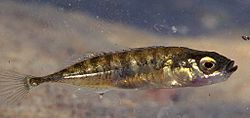Ninespine stickleback facts for kids
Quick facts for kids Ninespine stickleback |
|
|---|---|
 |
|
| Conservation status | |
| Scientific classification | |
| Kingdom: | |
| Phylum: | |
| Class: | |
| Order: | |
| Family: | |
| Genus: |
Pungitius
|
| Species: |
P. pungitius
|
| Binomial name | |
| Pungitius pungitius (Linnaeus, 1758)
|
|
| Synonyms | |
|
|
The ninespine stickleback (Pungitius pungitius), also known as the ten-spined stickleback, is a small fish that lives in fresh water and sometimes in salty water. It's found in many cool parts of the world, like Eurasia and North America. Even though its name suggests it has nine spines, it can actually have anywhere from 8 to 12!
Contents
What Does the Ninespine Stickleback Look Like?
The ninespine stickleback has a body that gets thinner towards its tail, which is shaped like a fan. It's longer and not as deep as its cousin, the three-spined stickleback. The easiest way to tell them apart is by counting the spines in front of their back fin. This fish usually has nine spines, but it can have between seven and twelve.
Instead of scales, this stickleback has small bony plates near its tail. Its mouth points upwards. It's usually grey or olive-brown with shiny sides that have darker stripes or spots. During the breeding season, males get a black area around their belly, and their belly spines turn white. Their eyes are dark with a gold ring around the pupils.
Ninespine sticklebacks live in streams, lakes, ponds, and rivers. They prefer places with lots of plants underwater. This is because their small spines don't offer much protection from predators.
Where Do Ninespine Sticklebacks Live?
This fish lives in freshwater systems that flow into the Arctic Ocean and the Atlantic Ocean. You can find them across Canada and Alaska, reaching as far south as New Jersey. They are also present on the Pacific coast of Alaska and in the Great Lakes area.
In Eurasia, they are found in many places. This includes the United Kingdom, Greenland, Turkey, and the Far East.
Reproduction and Parental Care
During the breeding season, which runs from April to July, the male ninespine stickleback builds a special nest. He hangs it on a piece of waterweed, usually about an inch above the bottom of the water.
The male then attracts a female to his nest. The female lays her eggs inside the nest and then leaves. The male is left to take care of the eggs and the young fish (called fry) when they hatch. He guards them until they grow their own spines. Once the young fish have their spines, the male chases them away to live on their own.
How Do Ninespine Sticklebacks Adapt?
The ninespine stickleback is a tough fish. It can live in both fresh and salty water, and it can handle a wide range of temperatures. Scientists have been studying how different groups of these fish, especially those in ponds, have changed over time. They look at how their bodies, life cycles, and behaviors have adapted to their specific environments.
For example, fish living in salty ocean water tend to slow down their body processes (metabolism) when it gets colder. They also have a larger liver compared to their body size, which helps them store more energy. Pond populations, however, can adjust their metabolism to survive in temperatures from six to nineteen degrees Celsius. These adaptations help them survive in less ideal conditions.
Ninespine sticklebacks also face different levels of oxygen in the water. They can't gulp air from the surface like some other fish. Instead, they rely on their gills to get oxygen. If the oxygen levels in the water are very low (a condition called hypoxia), they will rise almost to the surface. This is called aquatic surface respiration (ASR), and it allows them to breathe in the top layer of water, which has more oxygen.
Ninespine Sticklebacks in Culture
A famous British zoologist named Desmond Morris (born in 1928) studied the ninespine stickleback. In 1952, he wrote a paper about their behavior, which later became part of his PhD study at Oxford University. He described how these fish normally reproduce and also talked about some unusual behaviors he observed. Morris shared stories about his adventures with these fish and his many aquariums in his book Animal Days (1979).
See also
 In Spanish: Espinoso de nueve espinas para niños
In Spanish: Espinoso de nueve espinas para niños


